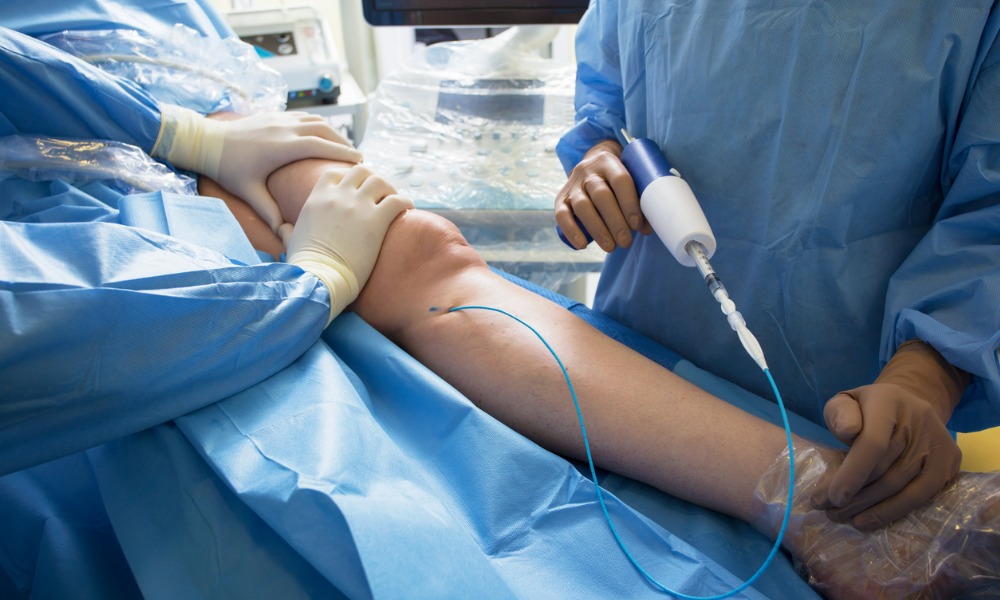
Judge rules doctors failed to examine patient for compartment syndrome in time to keep leg

An Ontario Superior Court of Justice judge has found that two doctors at a Toronto area hospital were negligent in caring for a woman who had to have her leg amputated after slipping on a clothes hanger at a Walmart store and dislocating her knee.
"The plaintiff's position was that both doctors were negligent in a number of ways, and the trial judge accepted some of those arguments and rejected some, but ultimately found that both breached the standard of care they were obligated to provide," says lawyer Ryan Breedon, who represented Jameela Fortune-Ozoike at trial.

Ryan Breedon, Breedon Litigation
And David Lackman of Gluckstein LLP, who worked on the case with Breedon, says that while it took several years for the case to make its way through the legal system, that is often the case with complex medical malpractice cases involving many parties. Walmart’s involvement in this case was an added twist as well.

David Lackman, Gluckstein LLP
“When you are dealing with multiple physicians, nursing staff and a totally independent retail facility, you’re dealing with a lot of evidence and expert opinion, and all of that is time consuming,” says Lackman, adding that the pandemic likely also slowed the legal process down a bit. “But if that is what it takes to get some resolution for our client, that is what it takes.”
He adds that medical malpractice cases are often vigorously defended as it involves the reputation of the medical staff involved. This also adds time to the process. And while he hasn’t been notified one way or another yet, the trial court decision could also be appealed, adding even more delay to resolution.
In this case, Justice Marie-Andrée Vermette recently ruled that "the breaches of the standard of care by Dr. [Calvin Tai-Len] Lian and Dr. [Kafai] Lai caused an injury to Ms. Fortune-Ozoike." She added: "I conclude that Dr. Lian and Dr. Lai were negligent in their care of Ms. Fortune-Ozoike and [is] entitled to judgment against both of them."
On Boxing Day 2013, Fortune-Ozoike went shopping at a Walmart store with her sister. She slipped on a hanger on the floor and fell to the ground. She was taken to Humber River Regional Hospital by ambulance and eventually diagnosed with a dislocation in her left knee.
By the following morning, the blood flow in her left leg was seriously compromised, and she was transferred by air ambulance to St. Michael's Hospital in downtown Toronto. There, she had vascular surgery in the early afternoon of December 27, 2013. However, it was too late to save Fortune-Ozoike's leg by then, and she had her leg amputated above the knee on January 4, 2014.
By the time of the trial , the only remaining defendants in the action were the two physicians involved in the care of Fortune-Ozoike at Humber River: Lian, an emergency physician, and Lai, an orthopaedic surgeon.
Before the trial, the plaintiffs entered a Pierringer agreement with Walmart and the hospital defendants. (A Pierringer agreement allows one or more defendants in a legal proceeding to settle with the plaintiff and withdraw from the litigation. This leaves the remaining defendants responsible only for the losses they caused.) Any amount paid by Walmart, or the hospital, would be deducted from the damages agreed upon by the parties.
The main issues in this case were whether the conduct of Lian and Lai breached the applicable standard of care and whether any breach of that standard caused an injury to Fortune-Ozoike.
Dangers inherent in knee dislocation injuries
Justice Vermette noted in her decision that a knee dislocation is a relatively uncommon injury. "It is also a serious injury that often involves the rupture of ligaments and associated risks of vascular and nerve injury."
The superficial femoral artery is the main blood vessel supplying blood to the lower body. As it passes through the back of the knee, its name changes, becoming the popliteal artery. The popliteal artery is the primary source of blood to the leg below the knee.
Injuries to the popliteal artery occur in about 20 percent of cases of knee dislocation, and some studies say it can be as high as 40-45 percent of cases. "Such injuries can make knee dislocation a limb-threatening emergency," the judge said.
The triage nurse who assessed Fortune-Ozoike when she arrived at Humber River gave her a triage score that indicates that while a patient's case is urgent, the patient is stable and does not need to be seen by a doctor immediately.
The trial heard that the emergency department was very busy that night, with some patients waiting several hours before seeing a doctor. Fortune-Ozoike was eventually x-rayed, which showed a knee dislocation and a fracture to her femur.
Lian contacted orthopaedic surgeon Lai, who answered the page while driving home after his shift, around midnight. After examining the patient's records and keeping in touch with the nurses looking after Fortune-Ozoike, Lai determined that she needed a vascular assessment but could not find a vascular surgeon who would accept her as a patient. He eventually got in touch with the vascular surgeon at St. Michael's, and the patient was taken there by helicopter that morning, where she received surgery to restore blood flow in the early afternoon.
Fortune-Ozoike's left leg did not return to normal health despite the surgery, and it was amputated a few days later. She then spent a few months in a rehabilitation facility.
Issues related to standard of care
At trial, expert witnesses testified for the plaintiff and the defence on the following issues regarding the proper standard of care:
After considering the testimony of the experts from both sides, Justice Vermette ruled that Lian did not breach the standard of care for not examining Fortune-Ozoike when the triage nurse spoke to him between 9:30 p.m. and 10 p.m.
However, Lian breached the standard by not properly examining Fortune-Ozoike for compartment syndrome when reassessing her at 1 a.m., in particular, palpating the compartments in the patient’s left leg. He also did not notify Lai of his concerns that Fortune-Ozoike might be developing compartment syndrome.
As for Lai, the judge ruled that his failure to return Lian's page before he left the hospital did not breach the standard of care. However, once Fortune-Ozoike was admitted to the hospital under Lai's care, "he became the most responsible physician."
While he may not have had to come to the hospital to examine the patient, "at a minimum he had to ensure that the physical examination that he would have had to perform was adequately performed by another health care professional."
The judge also determined there is no evidence that Lai took steps when Lian consulted him between 12 a.m. and 12:30 a.m. to ensure the emergency room doctor had performed an appropriate neurovascular examination of Fortune-Ozoike. The examination should have included a comparison of the injured limb with the uninjured limb.
On the matter of causation, the judge noted the expert witnesses for both sides had different approaches to the window of treatment that would have salvaged Fortune-Ozoike's leg, but the ranges for both was between 8 a.m. and 10:40 a.m.
The operation at St. Michael's "would have been placed at 8:35 a.m. had Dr. Lai not breached the standard of care at 12:30 a.m. and at 9:10 a.m. had Dr. Lian not breached the standard of care at 1 a.m.," the judge ruled. “Both of these times (8:35 a.m. and 9:10 a.m.) are within the window for treatment identified by expert witnesses for both sides." However, Fortune-Ozoike was not operated on until a few hours later.
Did Walmart breach standard of care?
Justice Vermette also looked at whether Walmart breached any standard of care and decided that the retailer did not. It had a regular program for "sweeping" for potential hazards and kept regular logs of that information.
"I conclude that Walmart did not cause any injury . . . and that there is no need to apportion fault between Walmart, on the one hand, and Dr. Lian and Dr. Lai, on the other."
Damages have been agreed upon but have yet to be made public.